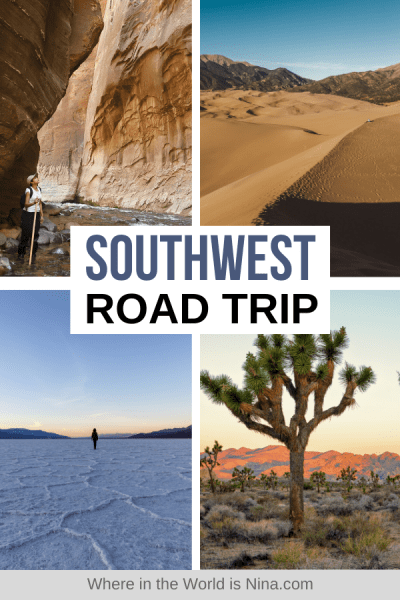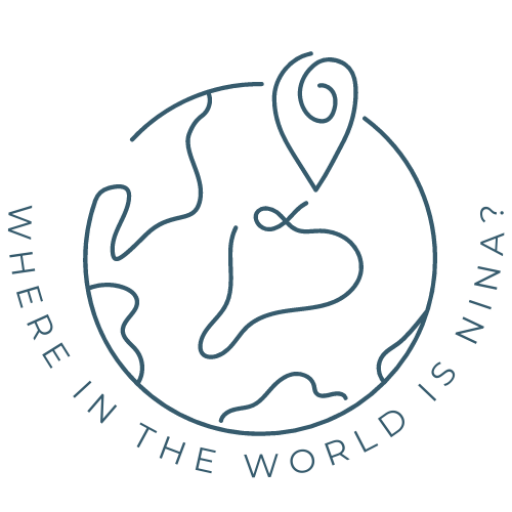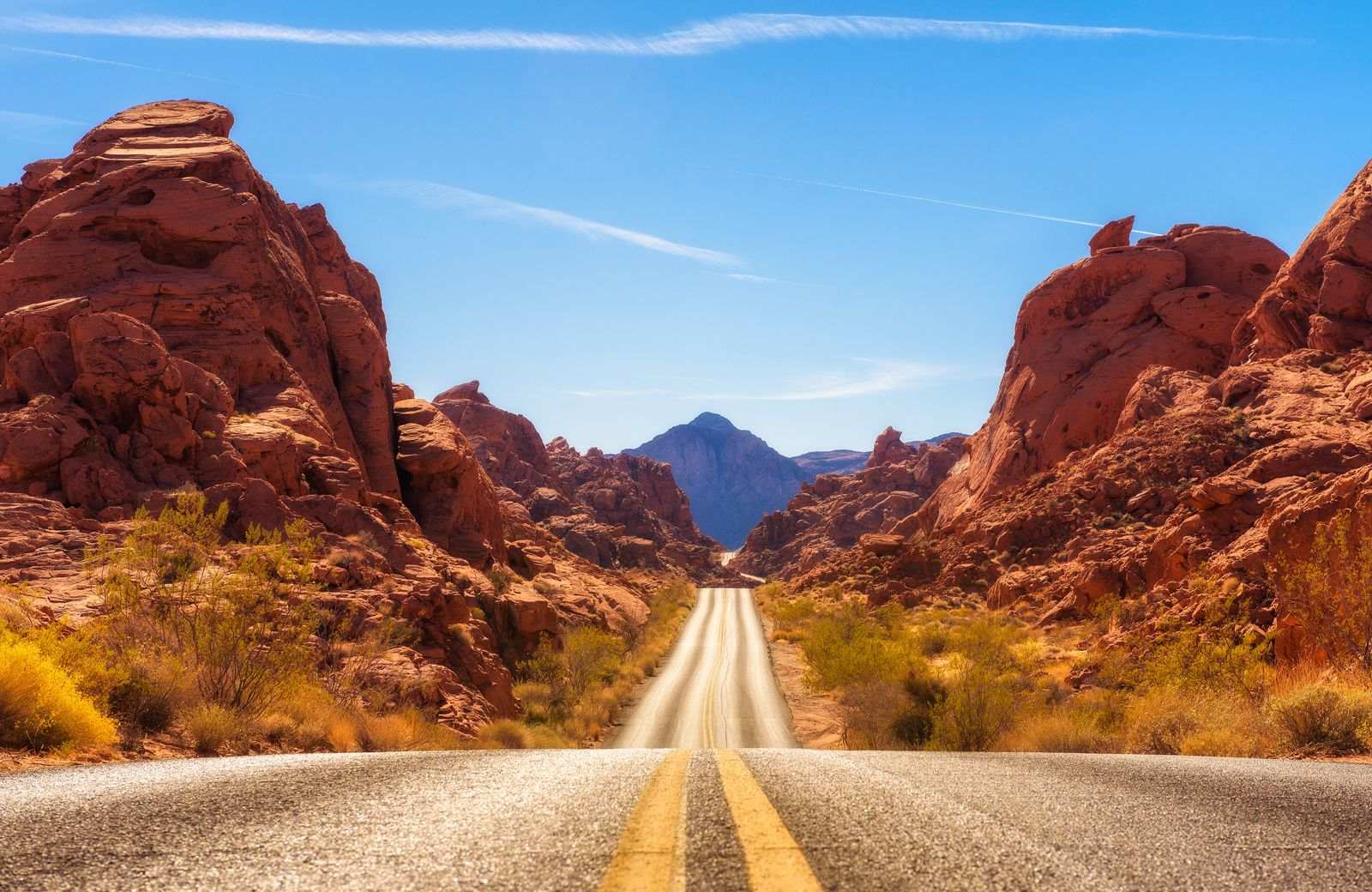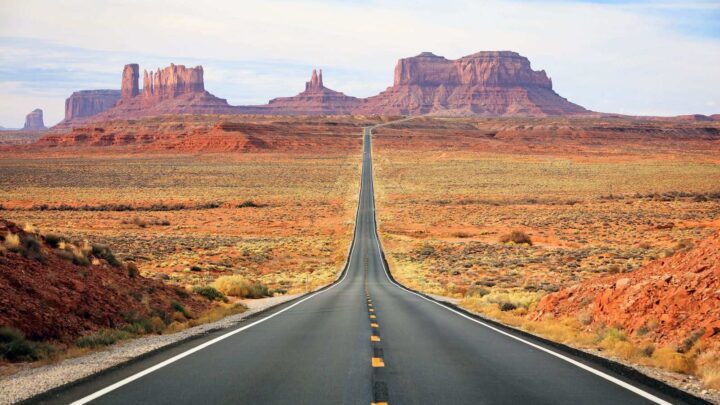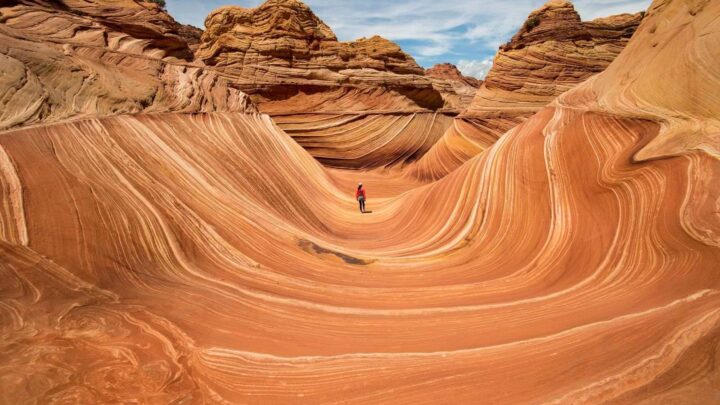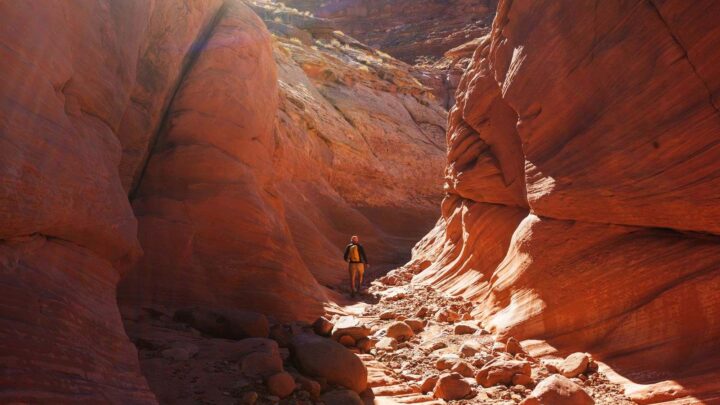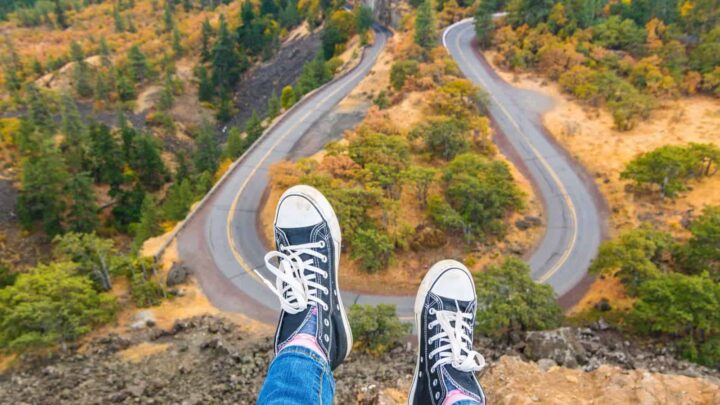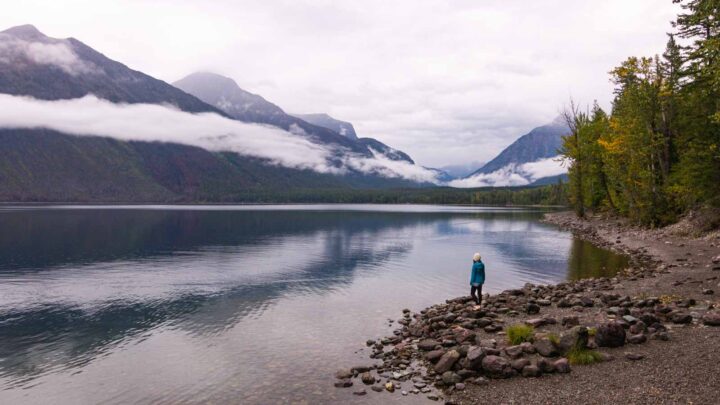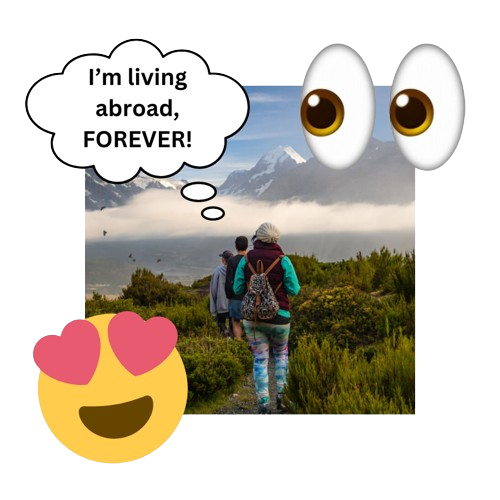Your Southwest Road Trip Itinerary (1 Week – 2 Months)
The Southwest region of the USA has some of the world’s most incredible landscapes I’ve ever seen. Rusty red and tan layered canyons, precarious rock formation, towering waterfalls, massive lakes surrounded by peaks, hikes that “take you to Mars…”
There’s a surprise around every corner and the best way to see everything is to do a Southwest road trip! That’s probably the only thing that’s not a surprise, it’s nearly impossible to see most of the wondrous things in the Southwest without your own car.
So rent or lug your vehicle over to this side of the USA for a bit and start exploring the Southwest!
Table of Contents
- Southwest Road Trip—CA, NV, AZ, UT, NM, CO
- Southwest Road Trip Through Colorado
- Southwest Road Trip Through Utah
- Southwest Road Trip Through Arizona
- Southwest Road Trip Through New Mexico
- Southwest Road Trip Through Nevada
- Southwest Road Trip Through California
- Southwest Road Trip Itinerary
- More USA Road Trips
Southwest Road Trip—CA, NV, AZ, UT, NM, CO
This area of the world is truly something special and so incredibly unique! I honestly had a hard time putting all of this together and I’m sorry (not sorry) to say, I went a bit overboard.
We have A LOT to cover here and unfortunately, if you don’t have over a month or so to spend in this region, you won’t get to see half of the things on this list. The US is so big and the Southwest is a huge chunk that involves around six states (depending on who you ask).
For the purpose of this post, our Southwest itinerary will include places in; Southern California, Nevada, Arizona, New Mexico, Utah, and Colorado. There’s a lot to take in, so you can first go through the list of awesome places to adventure around, and in the end, I’ll offer some tips on how to structure your time here.
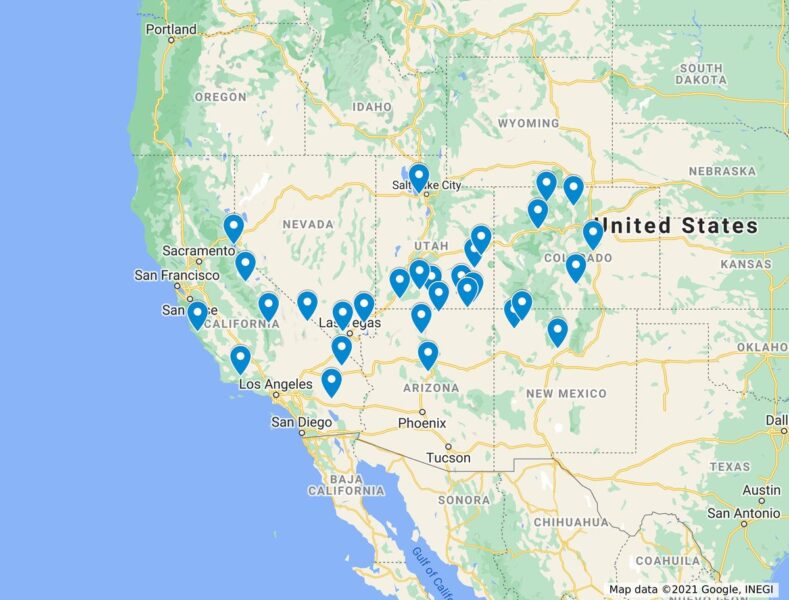
Don’t forget to read up on my other helpful road trip posts before heading out:
- Your Road Trip Essentials Packing List and Tips (+Printable Checklist!)
- How to Plan a USA Road Trip & Choosing a Vehicle
- 19 Mistakes to Avoid When on a Road Trip in the USA
Don’t lose this! Click to pin it now.

Southwest Road Trip Through Colorado
Grand Sand Dunes National Park
When you think of Colorado, the first thing that comes to mind is tall mountains and rugged valleys and wild grasslands. What you may not expect is miles of dunes that wouldn’t look amiss in the middle of a desert. Just 4 hours from Denver is the Grand Sand Dunes National Park, home to the tallest sand dunes in North America, a must-stop on any southwest road trip.
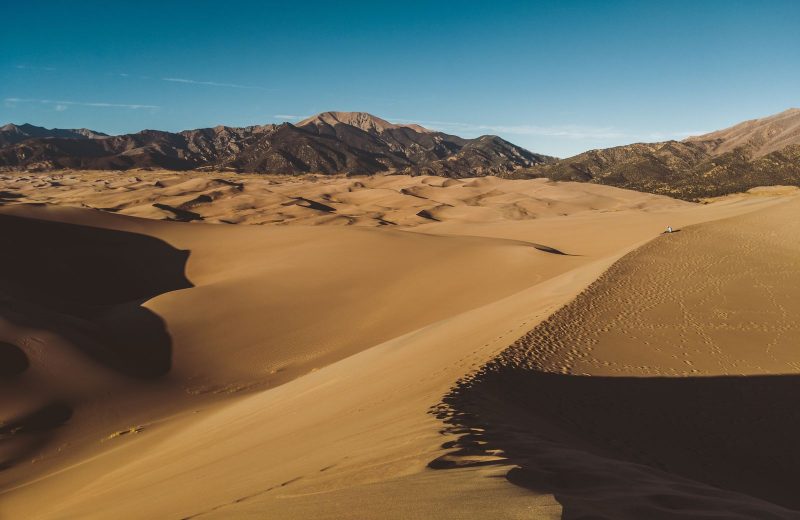
Covering 20 square miles, there are a lot of dunes here, but the biggest is the Star Dune, which towers above all the others. The dunes are a great place to explore, walking along the ridges, and taking in the views. If you are up for it, you can even have a go at sledding down the dunes for a little bit of an adrenaline rush.
Rocky Mountain National Park
You can’t visit Colorado without making a stop at the Rocky Mountains National Park. With towering mountains, abundant wildlife, fields of wildflowers, and the Trail Ridge Road, the highest paved road in the US, it certainly will not disappoint.
From challenging multi-day backpacking trips to short, flat, leisurely walks, there are hikes for every level of ability. Overall there are 350 miles of trail, so don’t expect to cover them all!
The park covers 266,714 acres, dotted with clear mountain lakes and streams, evergreen forests, alpine tundra, and snowcapped mountains, with a new adventure around every corner, making it a good point of interest on your southwest road trip itinerary.
The more daring should take a white water rafting trip. This tour not only provides some adrenaline-pumping white water trips but also ziplining courses and some more family-friendly rafting experiences.
Rock climbing enthusiasts can make use of the many exciting climbs in the area. The hundreds of granite faces, rocky peaks, and ledes have helped to make it a world-class climbing destination.
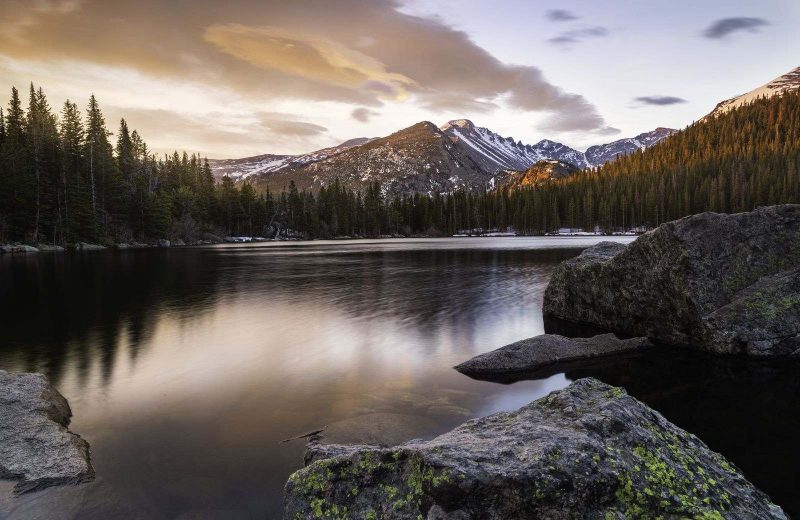
Lumpy Ridge is a favorite climb for many, with granite walls, pillars, and rock spires to tackle. Another challenging climb is Hallet Peak, climbing up 1000 vertical feet.
While in the park, keep an eye out for the varied wildlife that calls the park their home. You have a good chance of seeing some big horned sheep, golden eagles, and even black bears and mountain lions.
There are too many excellent hikes in the park to list, but one of the best is Mt.Ida. The views from the summit of this mountain are epic, with rocky, rugged terrain on the final leg of the journey.
A great lake hike is to Chasm Lake, there are panoramic views on the way up, and once you reach the alpine lake, you’ll be greeted with a backdrop of the famous ‘Diamond’ peak.
Emerald Lake is another lake hike that should make the list, taking you into the Tyndall Gorge, with plenty of subalpine lakes along the way, such as Bear Lake and Dream Lake.
Garden of the Gods
The unusual rock formations of the Garden of the Gods are particularly popular with hikers. The park is a registered National Natural Landmark, and offers dramatic views, some towering sandstone rock formations that reach over 300 feet, and a backdrop of the impressive Pikes Peak Mountain, making it one of the top things to do in the southwest.
You can learn all about the area in the Nature Center. There is plenty to do in the park, including biking, hiking, rock climbing, jeep tours, and adventure programs.
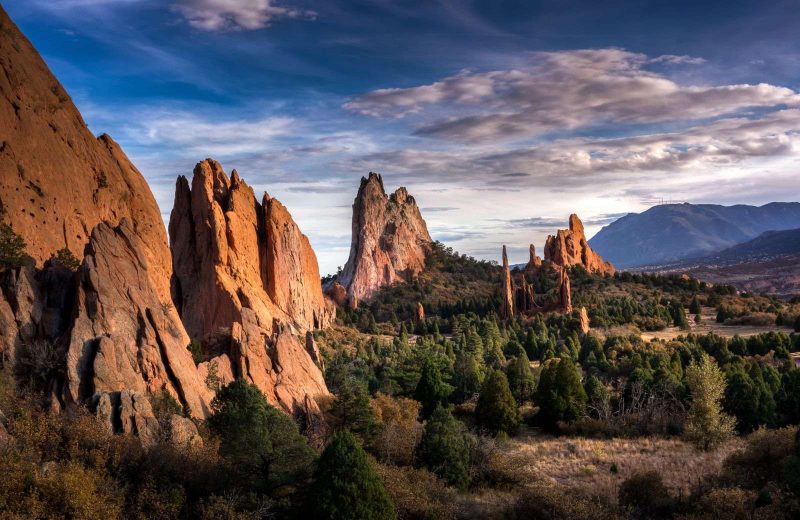
A jeep excursion is a great way to see what the park has to offer, as you’ll take in the sights of Cheyenne Canyon, waterfalls, a railroad tunnel, and countless stunning views while also enjoying a thrilling ride. For those that prefer to hike, there are 21 miles of trails to enjoy.
An easy place to start is the Perkins Central Garden Trail, an easy walk that is under two miles long at the heart of the park at the base of the highest rock formations. The Chambers/Bretag/Palmer Trail is longer at 3 miles and circles the whole park, covering rolling, rocky terrain.
Glenwood Springs and Hanging Lake
Around two and half hours from the city of Denver, over the Rockies and through the White River National Forest is Glenwood Springs, a small town that is known for having the largest hot spring pool in the world.
The pool contains 1 million gallons of water and has to be cooled to a temperature of 90-93 degrees all year round. For those that like things a little hotter, the water comes out of the Yampah Spring at 122 degrees, and is then cooled to 104 degrees in the Therapy Pool, so it really feels as though you are sitting in a hot bath.
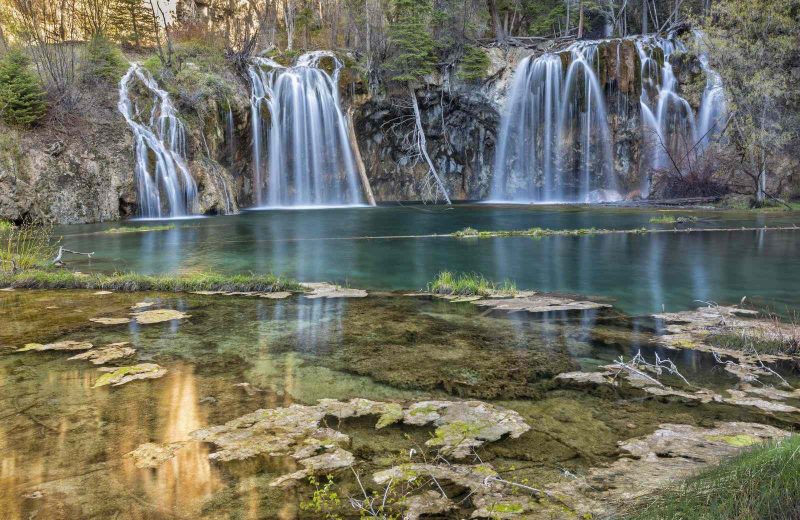
Once you have relaxed and enjoyed the calming waters in Glenwood Springs, take the short, 10-minute drive to the Hanging Lake Trail, which also has shuttle access in the summer months. It is a short and easy hike to the Hanging Lake, surrounded by small and picturesque waterfalls.
Steamboat Springs
Make the town of Steamboat Springs part of your southwest road trip itinerary, known for its outdoorsy vibe. There is plenty to do in the surrounding area, such as mountain biking and snowboarding in the surrounding peaks, hiking to the incredible Fish Creek Falls, and soaking in the Strawberry Park Hot Springs.
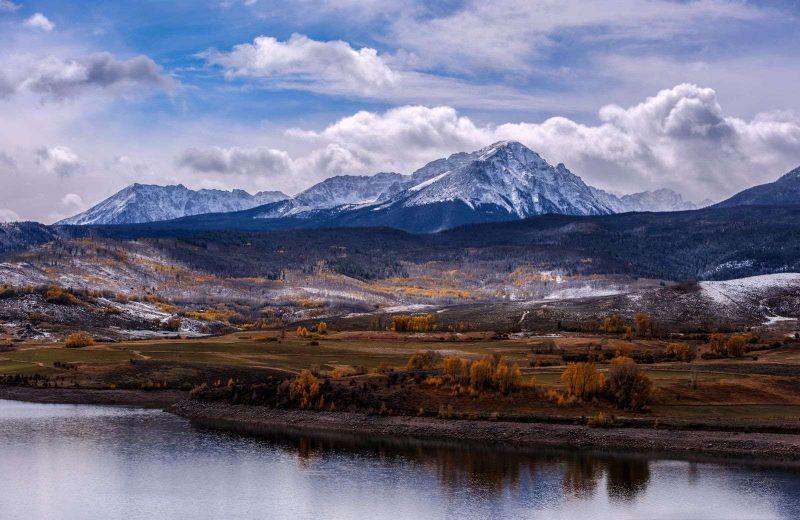
The hike to Fish Creek Falls is the real highlight here. You can take a gentle stroll along a paved path, more suited to families, and inexperienced hikers, or if you are up for a challenge, you can opt for the much longer trek that takes you up and over the top of a mountain.
RELATED: Your Adventurous Montana Road Trip
Southwest Road Trip Through Utah
Canyonlands National Park
As the name suggests, Canyonlands contains countless scenic canyons and towering buttes that have been formed by the twisting Colorado River. There are four districts within the park: Island in the Sky, The Needles, The Maze, and then the river and its tributaries.
The Island in the Sky is the most accessible district in the park just 10 miles from Moab and provides a scenic drive so you can easily see the many overlooks along the way. The area got its name due to its position over 1000 feet above the surrounding terrain, meaning the views are pretty incredible.
The area is home to many hikes. The hike to Mesa Arch will take you to a spectacular natural arch that is perched on the edge of a cliff, and the trek to the Grand View Point will reward you with a vista of The Maze, The Needles, and distant mountains. If you are feeling adventurous, you can take the additional mile to a second viewpoint.
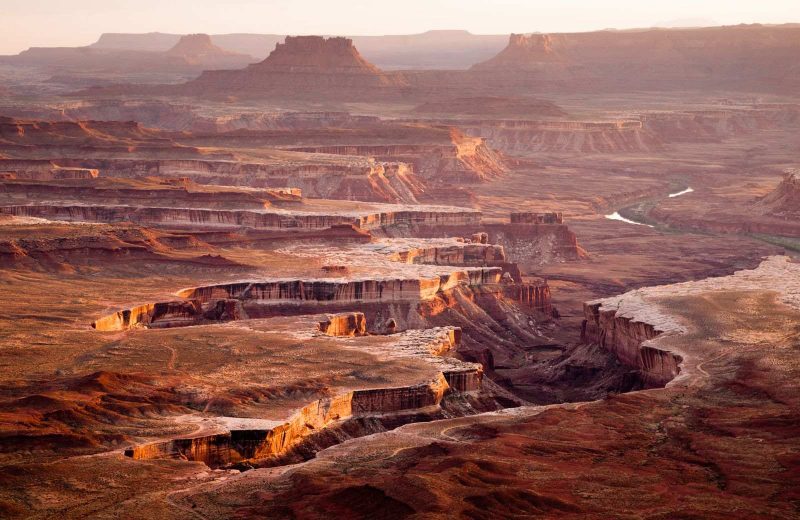
The Needles provides a more backcountry experience, so it’s often overlooked on southwest road trips, yet the colorful spires of Cedar Mesa Sandstone that dominate the area are imposing. Pay a visit to some of the main features either on foot or via four-wheel drives, such as Elephant Hill, Confluence Overlook, and Tower Ruin.
The Maze area is pretty remote, so would add a little time to your southwest road trip itinerary if you wanted to explore it. Due to its remoteness, visitors are also required to be self-sufficient and have the proper equipment.
An additional area within Canyonlands is Horseshoe Canyon. The area contains some of the most significant rock art in North America, such as at the Great Gallery. The hike to the Great Gallery is a 7-mile round trip, with a descent of 780 feet. Another way to explore this part of the park is on horseback.
Arches National Park
Although a smaller park, Arches has a lot to offer. It contains the world’s largest concentration of natural sandstone arches and is just 5 miles north of Moab.
There are over 2000 arches within the 76,518 acres of the park, as well as many other incredible rock formations such as huge balanced rock, and soaring pinnacles and spires. on your visit, you should take some of the trails to some of the best viewpoints within the park, many of which allow you to see the arches up close.
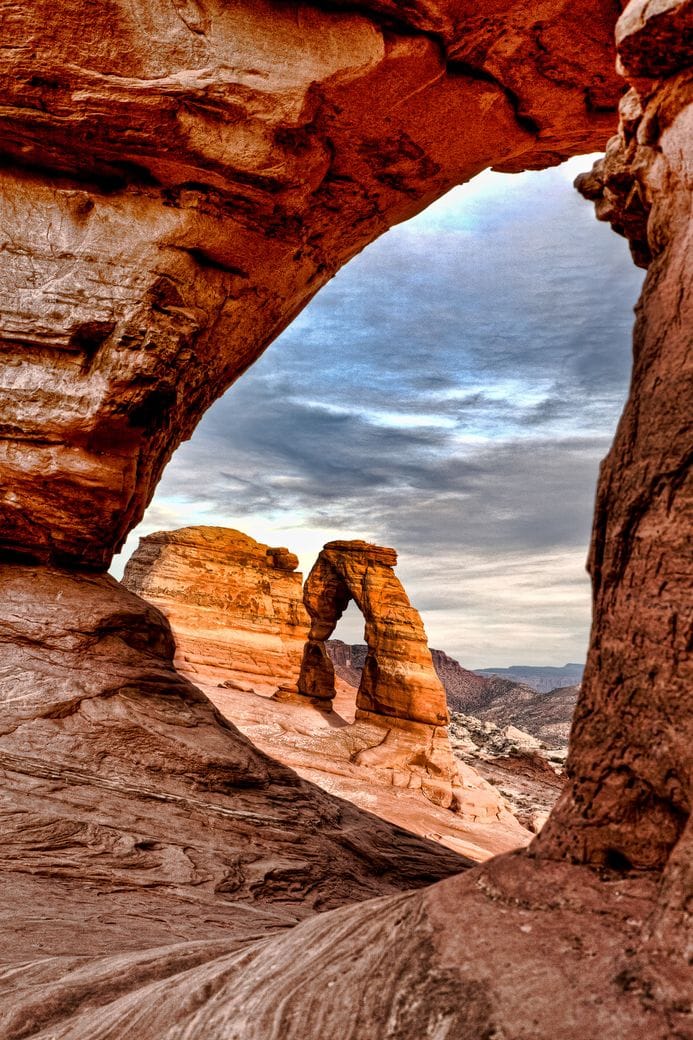
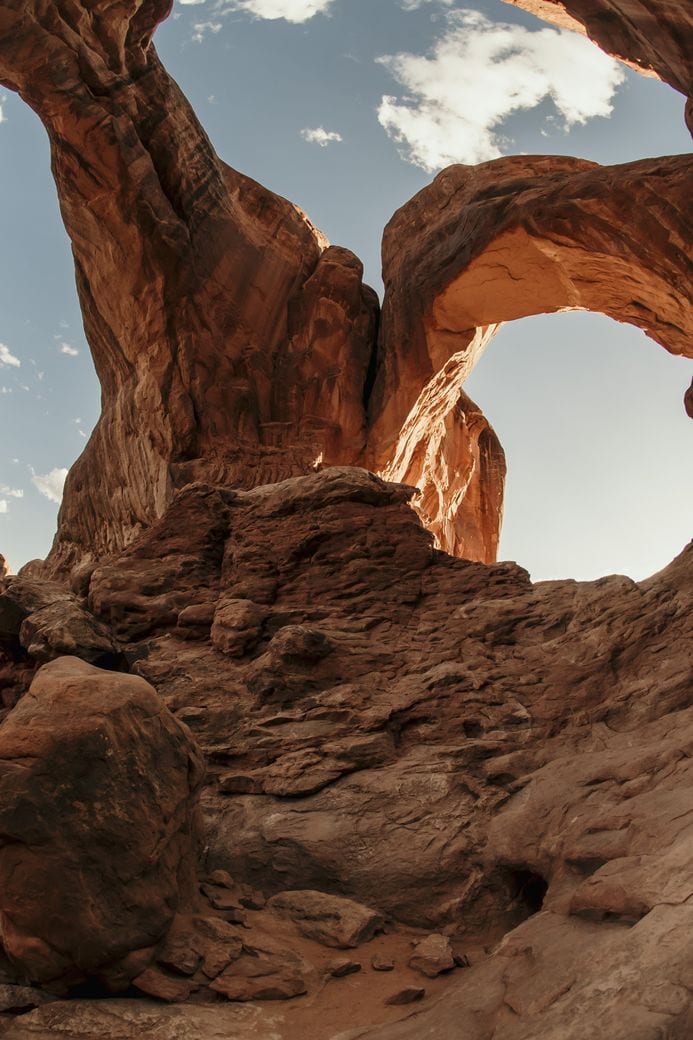
For an excellent overview of the park, drive the 36-mile Scenic Drive, making stops along the way to take some of the shorter, more accessible hikes such as the Park Avenue Trail.
Some of the best hikes in the park include those to the Double O Arch, Tower Arch, Delicate Arch, and Landscape Arch. Park Avenue is another great place to explore, descending down into an incredible canyon, or the short paved route to the Balanced Rock.
Glen Canyon
Covering 1.25 million acres, there is certainly a lot to enjoy in Glen Canyon National Recreation Area. Expect geological wonders, scenic vistas, and towering orange cliffs, making it an exciting place to visit in southern Utah and one of the best things to do in the southwest.
One of the most visited and well-known parts of the park is Horseshoe Bend. Take the hike to the overlook, which is a gentle slope of 1.5 miles, and be rewarded with one of the most incredible views of the canyon, where the river has curved around a sandstone escarpment.
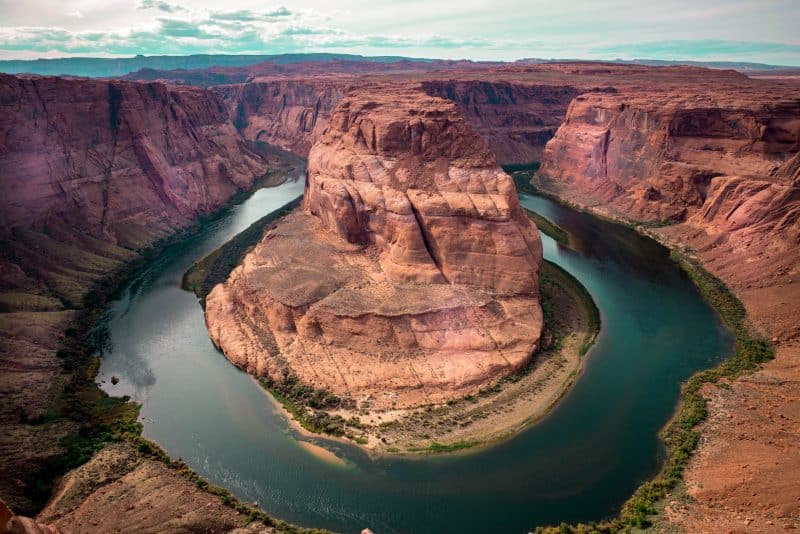
Another must-see in Glen Canyon is Rainbow Bridge, one of the world’s largest known natural bridges. There is around a mile hike to the bridge.
While in the area, you should also make a stop at the Glen Canyon Dam, an engineering marvel. It rises 710 feet above the bedrock in order to harness the power of the Colorado River. It is the second-highest concrete dam in the United States, so it is well worth seeing, and if you are particularly interested, you can take a guided tour.
Goosenecks State Park
Not many people have heard of Gooseneck State Park, as it is often overshadowed by some of the bigger parks in the area, but it is seriously impressive. It lies on the edge of a deep canyon above a sinuous river meander that is known as a ‘gooseneck.’
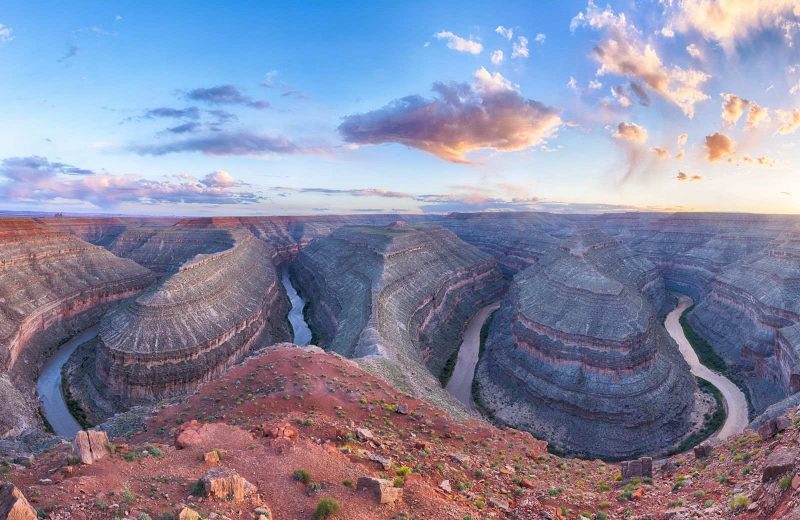
The park offers some impressive views of the canyon. This part of the San Juan River twists and turns for 6 miles while actually only advancing one and a half miles on its way to Lake Powell. Honaker Trail is a good trail nearby that offers various viewpoints, but there are no trails within the park itself.
Grand Staircase-Escalante
Whether you are traveling along Scenic Byway 12 or on Highway 89 on your southwest road trip, it is hard to miss the Grand Staircase-Escalante.
This vast area of Utah is made up of a colorful mix of sandstone cliffs that tower above a number of narrow slot canyons. The hiking scene here is world-class, containing the most extensive network of slot canyons in Utah.
Head to the Kodachrome Basin State Park in the northwest corner of the monument for some of the best day hikes. The Cottonwood Canyon Narrows is one of the most exciting hikes in this area, and Calf Creek Recreation Area also has a good selection of hikes, such as hikes to Lower and Upper Calf Creek Falls.
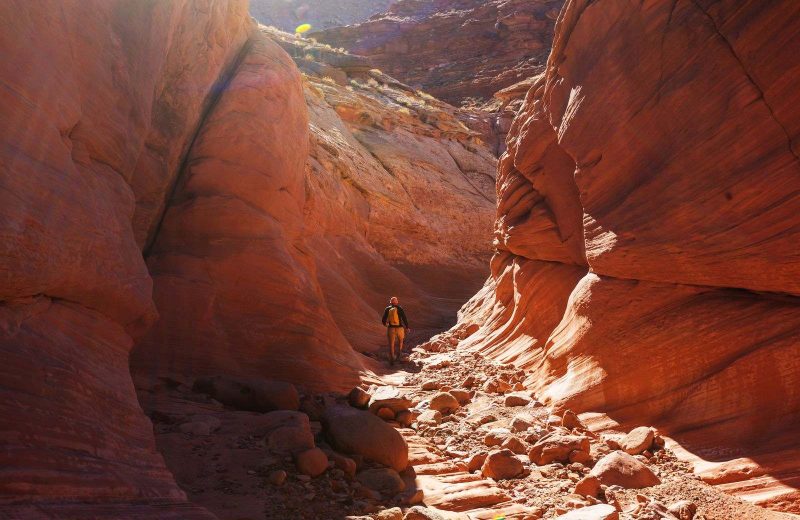
If you would prefer to drive to see some of the sights in this vast region. The trip to Old Paria ghost town passes some incredible geographical formations and sandstone cliffs banded in delicate hues of red, orange, and gold.
The Cottonwood Canyon Scenic Backway is arguably the best scenic drive in the Monument. It provides access to some of the most well-known points of interest, such as Grosvenor Arch and the Cockscomb.
RELATED: 17 Legendary American Road Trips
Zion National Park
Zion National Park is another of Utah’s great natural wonders. Filled with serpentine canyons lined with sheer cliff faces and rocks a rainbow of colors, it is an incredible place to visit.
Zion lies where the Colorado Plateau, the Great Basin, and the Mojave Desert all converge, resulting in a spectacular show of hoodoos, towering peaks, and the thunderous flow of the Virgin River, which cuts through the landscape. Zion Canyon is the main draw here and is often described as the desert equivalent to the Yosemite Valley.
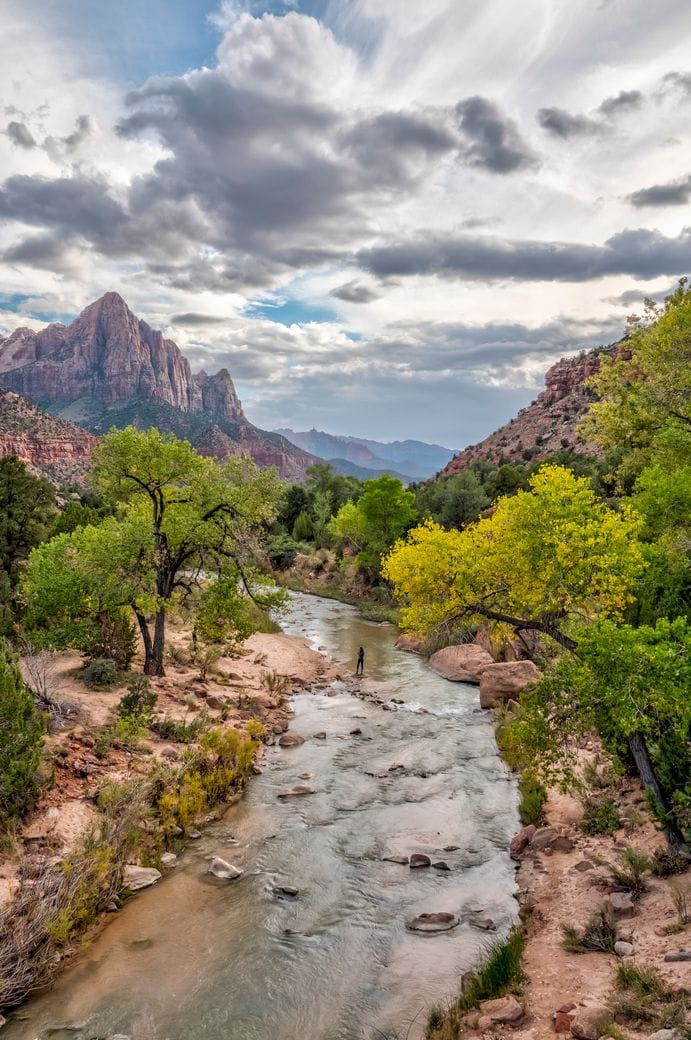
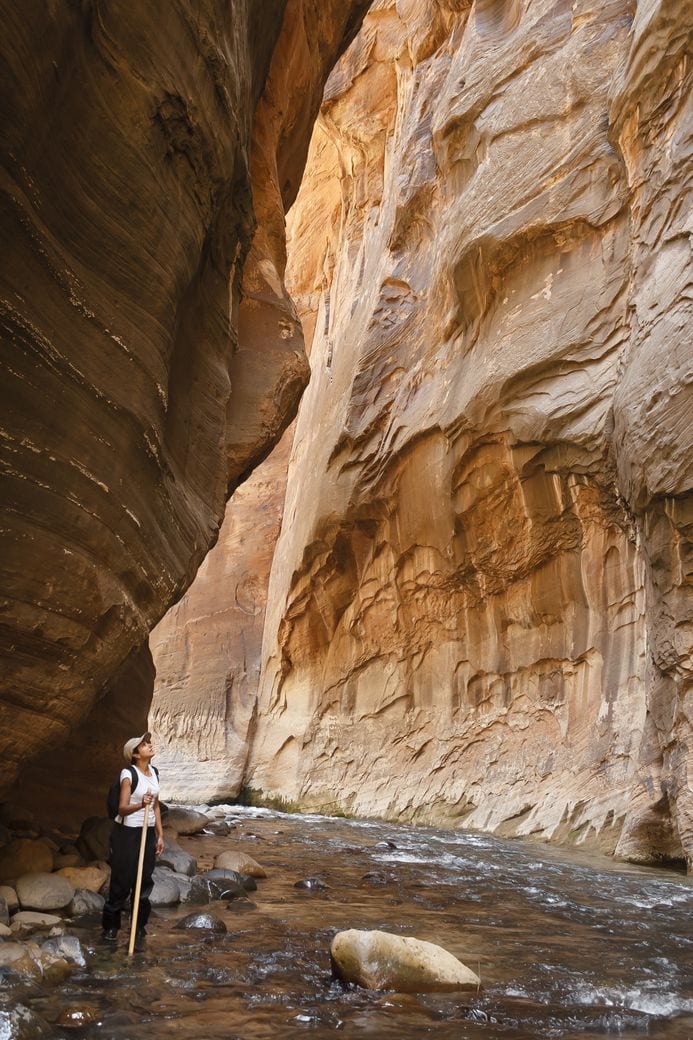
For some of the best views, take the 5.4-mile round trip hike to Angels Landing. Be aware that the last half a mile requires climbing up a giant sandstone with just a few chains to hold onto. If you don’t fancy that kind of adrenaline rush, then opt for the Observation Point, a less scary alternative that still offers great views of the canyon.
Although exploring the valley is a must-do when visiting the park, it is far from all that Zion has to offer. Head to the northwest corner and to Kolob Canyons, a series of parallel fissures separated by sandstone.
Hike the trail at the Kolob Canyon Viewpoint to admire the stone glow fiery red at sunset. The Emerald Pools also should not be missed, a beautiful area complete with waterfalls and hanging gardens.
RELATED: 8 of The BEST Hikes in Southern Utah You’ve Got to Check Out!
Bryce Canyon
The incredible Bryce Canyon is most known for its monstrous hoodoos held within its red, orange, and pink amphitheater. Rows of rock pillar cover the landscape, so many that it looks surreal. The Navajo Loop is the most popular in the park, and it is not hard to see why. Starting at Sunset Point, there are incredible views from the get-go. You will pass the Silent City, which is full of hoodoos and spires before heading into the narrow slot canyon of Wall Street.
A great, adventure fuelled activity in the park is a guided ATV tour. Not only is it exhilarating, but you can cover a lot of ground and see most of the park’s highlights, making it a fantastic stop on any southwest road trip itinerary.
Lake Powell
Within Glen Canyon is Lake Powell, which is the second-largest human-made reservoir in the states, at 186 miles long and 500 feet deep. It is also home to some of the largest fish found in Utah, making it a popular spot for fishermen. Lake Powell attracts all different types of anglers, from professionals to those that just fancy messing around with a line.
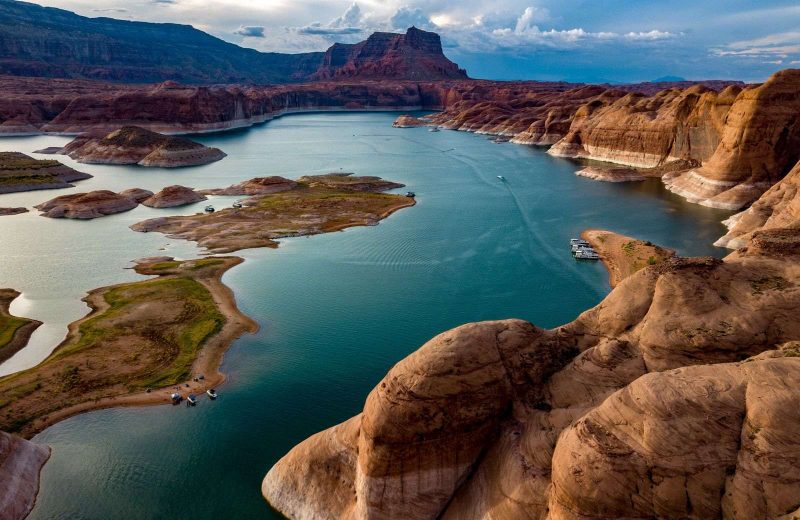
The lake offers a mecca of opportunities for outdoor adventure, including kayaking and stands up paddleboarding. You can rent both from the shores of the lake, with the option to head out onto the water just for an hour or for the whole day.
If you would prefer someone else to do the hard work for you, why not take a scenic boat tour? Many boat tours are offered from the Wahweap Marina in the town of Page, Arizona; the lake is shared by both states.
Salt Lake State Park
Although a little off route, a visit to the Great Salt Lake is well worth it. It is the largest saltwater lake in the Western Hemisphere, providing some outstanding scenery and an abundance of recreational opportunities. The lake’s beaches offer a beautiful place to relax and enjoy the surroundings, while hikers can head to Ensign Peak on the edge of Salt Lake City or make use of the many trails around Antelope Island.
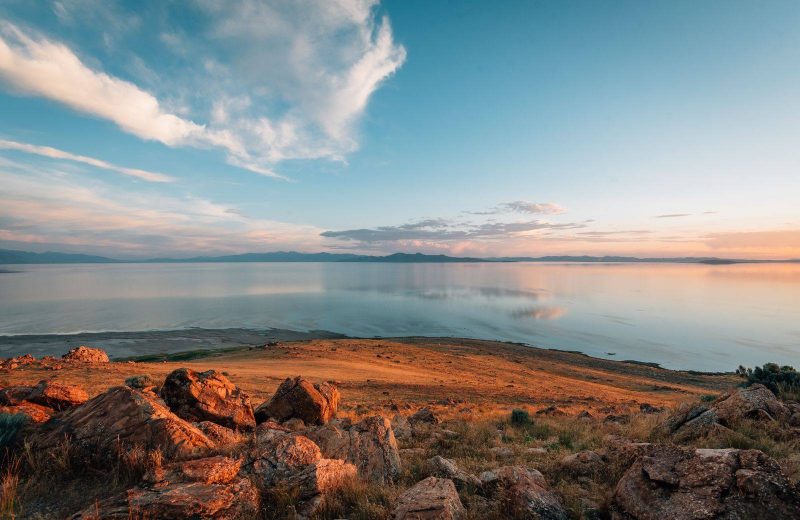
At Antelope Island State Park, you can expect to find white sand beaches and water so buoyant that you can float on it without a problem, with the salinity of the water averaging around 12%. Why not take to the water on a motorboat or a kayak to explore the shores from a different perspective? With 10,000 miles of shoreline, there is plenty to explore and can be one of the most rewarding places to paddle in the state.
When on Antelope Island, keep an eye out for wildlife, which is abundant in the area. Bison, antelope, deer, coyotes, elk, bobcats, and birds all roam freely on the island, and it is not uncommon to make a sighting. There are facilities here for camping and picnicking, so it is a great place to relax and spend time with family.
RELATED: Your Adventurous Utah Road Trip
Southwest Road Trip Through Arizona
Grand Canyon
Grand Canyon National Park is arguably one of the most popular attractions and natural wonders in the whole of the US; therefore, it is a must-visit on any southwest road trip. No matter how many photos you have seen of this natural phenomenon, it will never prepare you for how you feel when you stand on the rim of the canyon.
The canyon is split into two sections, the North Rim and the South Rim. The most visited part is the South Rim, as it is generally more geared towards tourists. There are more viewpoints and a much wider range of visitor services. There are tons of hiking trails and other activities to enjoy. If you are looking for that iconic view of the grand canyon, then this is the place to go.
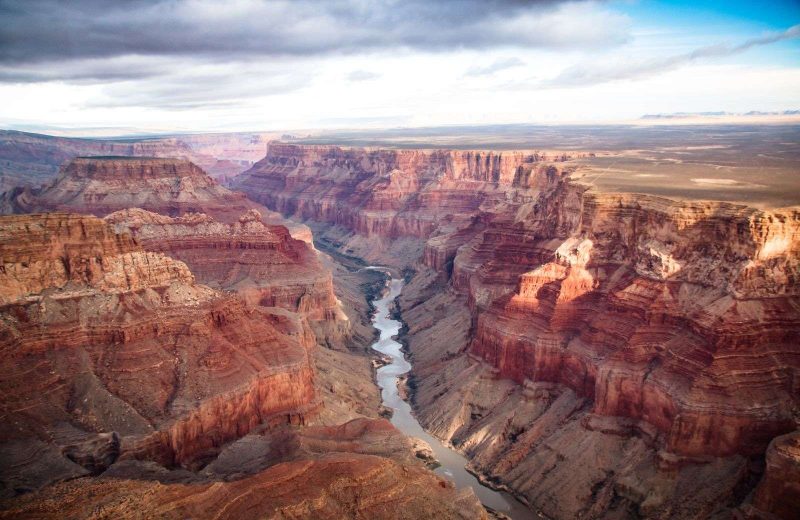
If you are feeling fearless, why not take on the Skywalk, a hair raising glass bridge that extends out over 70 feet over the canyon. Other activities here include zip lining, pontoon boat rides, river rafting rides, and mule rides.
A unique way to see the park is to cruise the Colorado River in a dory, a nimble, and quick craft that swings and rocks and rapids are making for an exciting and wet adventure. If you are feeling especially daring and want unparalleled views of the canyon below you, take one of the many helicopters tours that are available in the area.
Hiking below the rim is an activity that attracts only 5% of the park’s visitors, but there are some excellent short hikes that take you down over the rim, so you can then look back up at the canyon walls. The Ooa-Aah Point is about a third of the way down and offers spectacular views. Plus, it will be pretty cool to say you have hiked into the Grand Canyon.
If it is quiet trails and undisturbed wildlife you are after, then it is the North Rim you need to head to. The rim here averages about 1000 feet higher than its southern counterpart, leading to a considerable change in the views, climate, and vegetation.
Antelope Canyon
Just east of Page in Northern Arizona is the incredible Antelope Canyon. This slot canyon is famous for its towering walls and wave-like structure in the rock. When the light hits the rocks at the right angle, the light beams shine down through the cracks creating an incredible sight.
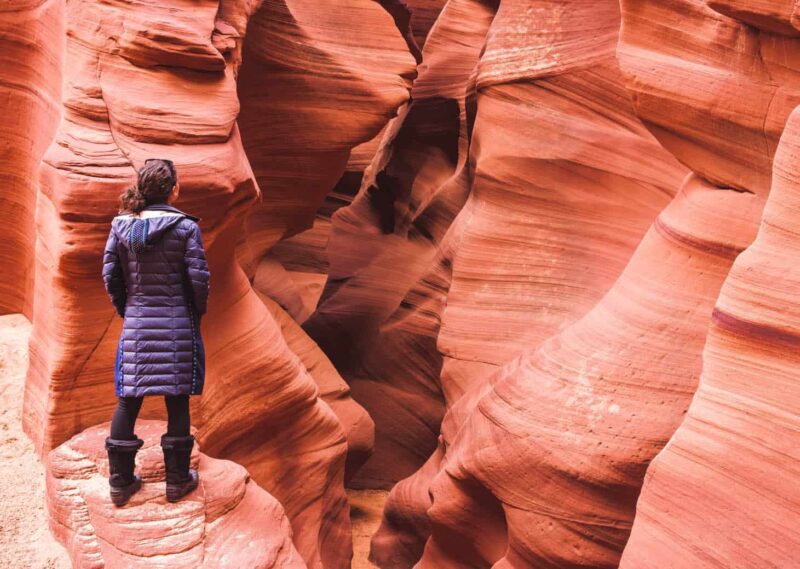
To explore this natural wonder, you must take a guided tour. The tour guides will be able to give you tons of information about the history and geology of the area.
RELATED: Antelope Canyon in Winter + Which Tour to Take (Hint: Not Upper or Lower!)
Painted Desert
Staring out at the colorful rocks of the painted desert will make you feel as though you have stepped right into a painting. These rocky badlands encompass 93,500 acres, featuring rocks in every hue, from rich reds to deep lavenders.
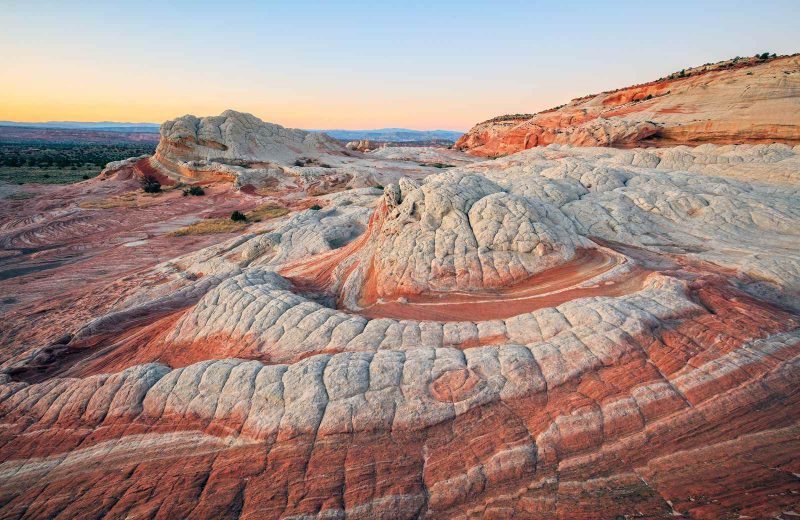
You can’t fully experience the wonders of this park without also visiting the Petrified Forest National Park, next to the painted desert. Thanks to erosion, a once magnificent pine forest have resurfaced from millions of years ago, revealing the many skeletons of its past.
Monument Valley
Sitting on the border between Arizona and Utah is the incredible Monument Valley, part of the Navajo Tribal Park, and one of the best things to do in the southwest. These towering rocks really are the symbol of an American road trip.
The giant red rocks tower above the valley below, reaching a height of 1000ft above the ground. Be sure to drive to the otherworldly trio of West Mitten Butte, East Mitten Butte, and Merrick Butte. It is possible to drive right through Monument Valley, visiting the main sites in a few hours, but if you really want to explore it, it is easy to spend a whole day in the area.
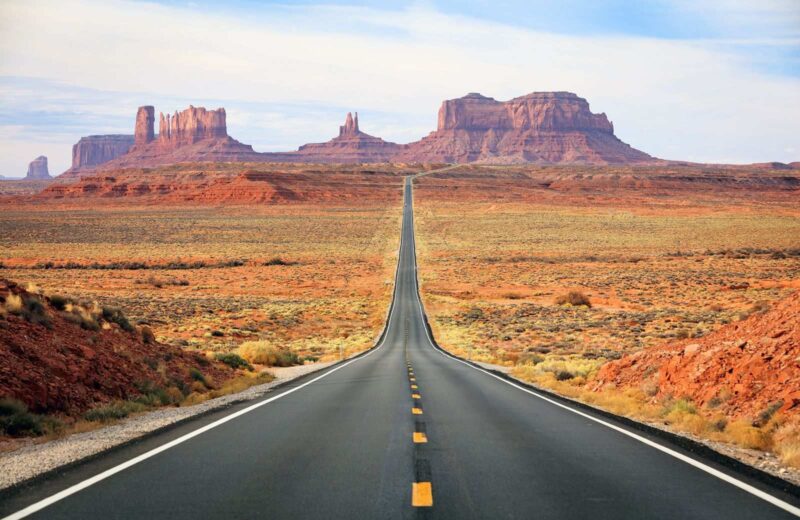
Take the 17-mile Tribal Park Loop, often referred to as the Valley Drive, which will take you past some of the main sites in Monument Vally, starting and ending at the Monument Valley Visitor Center. If you want to explore the valley even further, you will have to schedule a tour with one of the tour providers.
The Wildcat Trail is the only self-guided hike you can do in the valley. It is a 3.2-mile loop that circles around Mitten Buttes and Merrick Butte, offering some great photo spots along the way.
Red Rock
The 286-acre nature preserve of Red Rock State Park is a beautiful place to visit, boasting lush forest landscapes contrasted by the towering red rock hills. A 5-mile trail network is made up of connecting loops, which will take you to some of the best rocks of Sedona, while also taking you along the greenery of Oak Creek.
The Eagle’s Nest Loop will take you to the highest point in the park, offering some fantastic views of the red rock escarpments from which the park got its name.
RELATED: Your Adventurous Arizona Road Trip
Southwest Road Trip Through New Mexico
Bisti Badlands
The Bisti Badlands are little known or visited, but who knows the reason why. This incredible area is made up of a colorful expanse of unusually eroded rocks and undulating mounds covering the northwest corner of New Mexico. The elements have worked for eons to develop a landscape made up of hoodoos, arches, bridges, balanced rocks, and small slot canyons.
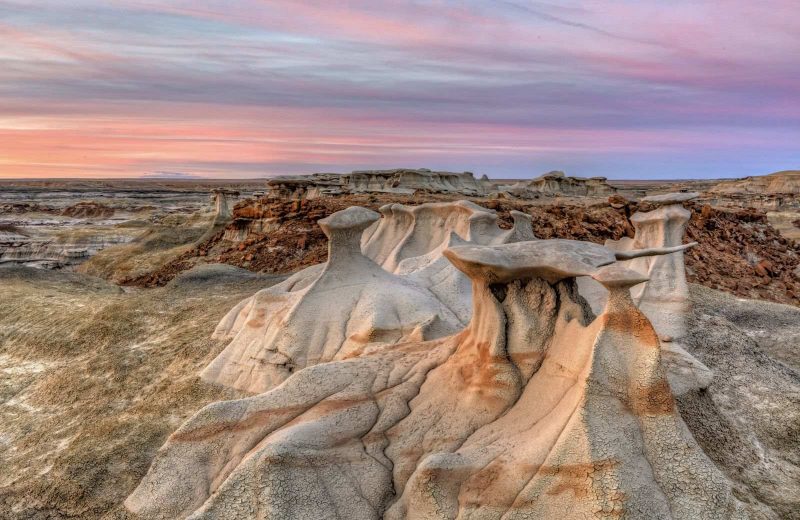
Although there are no established trails, most people explore by walking along the ravines and valley floor. Just be careful of loose crumbling rocks and make sure you can find your way back, especially as there is no water in the area, and it can get sweltering. Keep your eyes peeled for fossils of bones and teeth, as a large number of dinosaur species used to walk the old-growth forests of the land, leaving a trail of evidence in their wake.
Some of the best rock formations include the Bisti Wings, the Brown Hoodoos, Vanilla Hoodoos, Conversing Hoodoos, Manta Ray Wing, the Alien Egg Hatchery and many others.
RELATED: Your Road Trip Essentials Packing List and Tips (+Printable Checklist!)
Angel Peak Scenic Area
Made up of more than 10,000 acres of rugged terrain around 30 miles from Farmington, Angel’s Peak could be a short and sweet stop on your southwest road trip. The main landmark is, of course, the 7000 foot Angel Peak which can be seen for miles in all directions. The best way to see the unique banded colors of the badlands is to take the short rim hike.
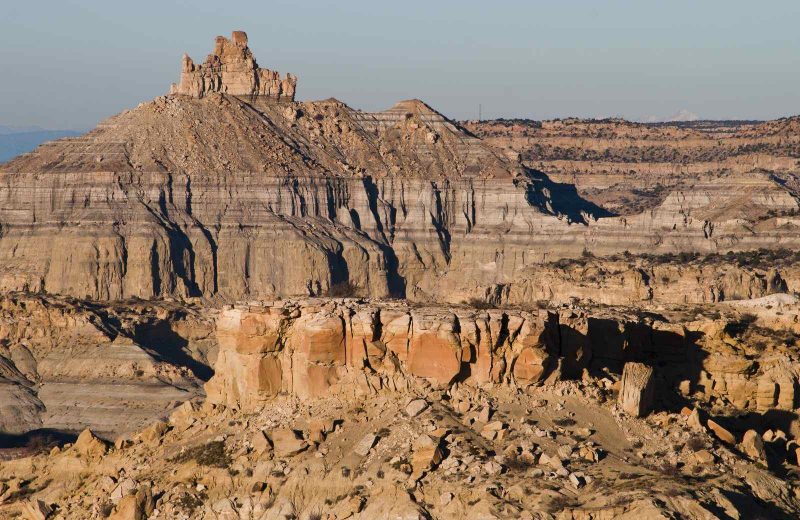
There are three picnic areas where you can enjoy lunch with a view over the canyon rim, overlooking the Kutz Canyon Badlands and Angel Peak. The area offers an exciting place to stay, with developed camping sites located along the rim road. From the campgrounds, a short nature trail winds its way through the plant life that has found a niche along the rim.
Kasha-Katuwe Tent Rocks National Monument
Observe the wonder of nature and incredible geological processes at the Kasha-Katuwe Tent Rocks National Monument. The area got its name from the cone-shaped tent rock formations, which are the product of volcanic eruptions that occurred 6 to 7 million years ago.
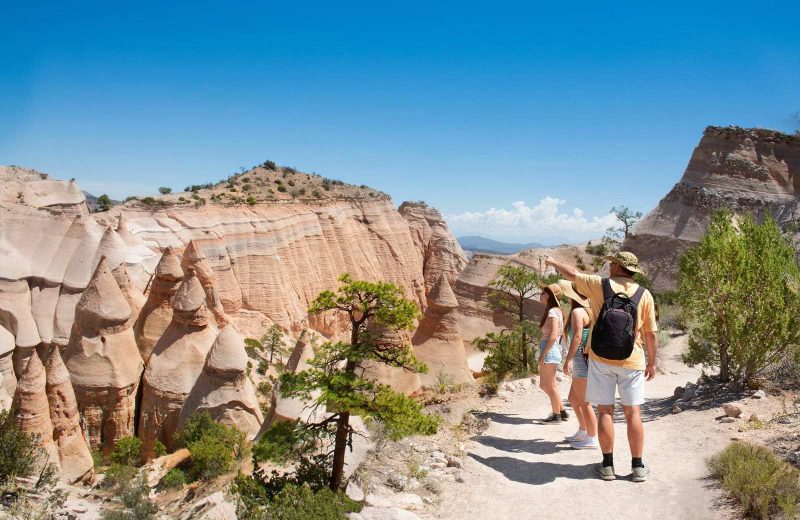
To get the best look at the national monument, take one of the national recreational trails. Cave Loop Trail is an easy 1.2-mile walk taking you to some of the best geological formations. Canyon Trail takes you 1.5 miles one way into a narrow canyon, before climbing up to the mesa top for incredible views of the Rio Grande Valley and the Sandia, Jemez, and Sangre de Cristo Mountains. For a flat, wheelchair-accessible trail, take the Veterans Memorial Trail, overlooking the picturesque Peralta Canyon.
Southwest Road Trip Through Nevada
Valley of Fire
The incredible Valley of Fire State Park contains more than 2000 years of history in the ancient petrified trees and petroglyphs that dot the dramatic landscape. The valley is world-renown for its 40,000 acred of bright red Aztec sandstone outcrops, and this factor alone makes it well worth a stop on a southwest road trip itinerary.
Located 50 miles northeast of Las Vegas, it is easily reachable, and on a sunny day, the rock formations look like they are alight, which is where the park got its name.
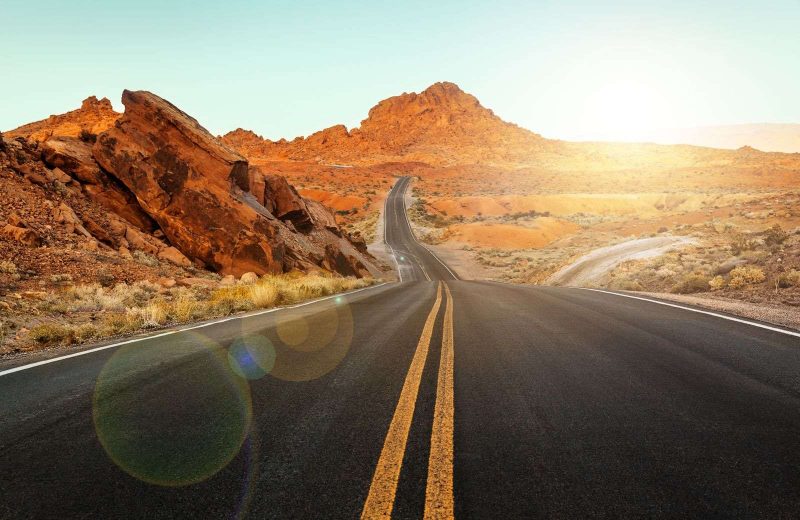
Driving through the park on Mouse’s Tank Road is the easiest way to enjoy the views, stopping at some of the main points of interest along the way. Take the Mouse’s Tank hike, which is a relatively short road trip ending at a natural rock basin, or the mile-long Rainbow Vista Trail that climbs up onto a hill, providing panoramic views of the Valley of Fire.
Pink Canyon is a cool place to stop, and is exactly as the name suggests, with twisting lines of pink-hued rock. The Fire Wave is another point of interest that should not be skipped and is the most famous spot in the valley. White and red striped cover the landscape, which can be reached via a 1.5-mile round trip hike. For a hike that rivals the Antelope Canyon, take the 1.25-mile loop hike to the White Domes.
Red Rock
As you might have guessed, Red Rock Canyon gets its name from the incredible red sandstone formations that are found within the region. This is, without a doubt, one of the most scenic places in south Nevada, with startling contrasts between the red sandstone and thick layers of gray limestone in the towering 1800 foot cliff faces. The canyon is vast, covering 195,000, yet is just 17 miles from the bright lights of the Las Vegas strip.
Rock climbing and horseback riding are both very popular activities in the canyon, with numerous trails winding through the firey rock. Serious rock climbers have a lot of options here, from sandstone ridges to huge boulders. Overall there are more than 1200 named rock climbing routes, some of which are the best vertical routes on the continent. Tunnel Vision and Olive Oil are two famous epic climbs.
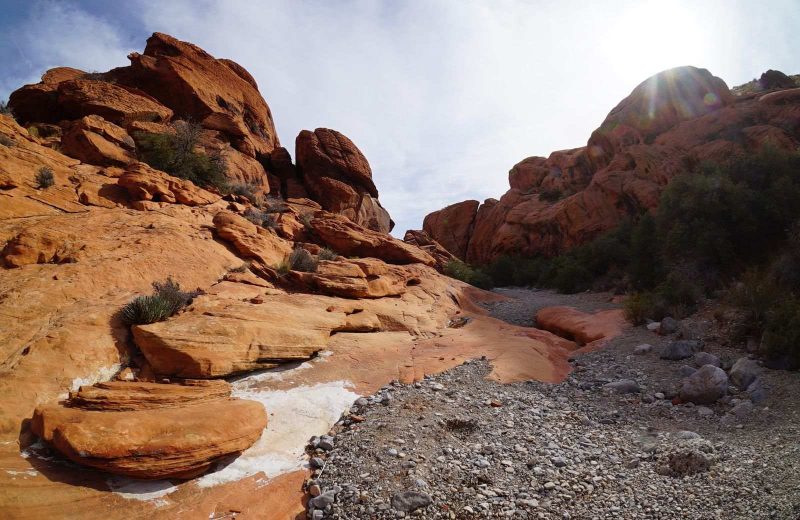
If you want to cover a lot of ground but are short on time, then take the 13-mile scenic drive that will take you to some of the most incredible spots. If you have a bit more time to explore, hiking is the way to go. Routes encompass canyons, ridges, unique rock formations, caves, and desert plant life.
An easy trail is the Lost Canyon Children’s Discovery Trail at just 0.75 miles. Although short, it contains a 200-foot waterfall, natural tunnels, stone stairs, a boardwalk, and petroglyphs, so it is pretty exciting.
The Turtlehead Peak Trail is much more challenging. It’s a strenuous 5-mile hike that will take you past exposed ledges with an elevation gain of 2000 feet. Yet the best views come with the most work, and you will be greeted with a spectacular view f the conservation area, Las Vegas, and beyond.
Lake Tahoe
When you first set eyes on Lake Tahoe, it will be hard for you to find the words for how beautiful it is. It rests on the California-Nevada border and draws visitors in by its steep granite cliff sides, surrounding mountains, and crystal clear waters, all of which have helped build the lake’s reputation of being one of the most impressive bodies of water in the States.
Emerald Bay State Park should be the first stop on the shores of Lake Tahoe; it is sheltered by towering trees, colorful granite cliffs, and incredible panoramas. The crown jewel of the park has to be the Emerald Bay Lookout with new photo opportunities everywhere you look.
Jump on a boat and head out onto Fannette Island, which is the only island on the whole of the lake. Some of the best beaches on the lake can be found at the Kings Beach State Recreation Area, making it ideal for sunbathing, swimming and boating.
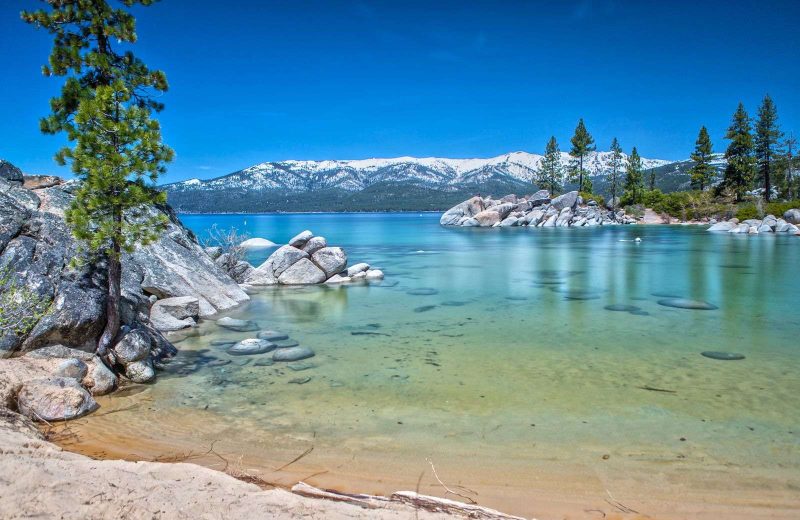
One of the most incredible things to do in the park is to don some scuba gear and dive under the water to explore the Underwater Park, the final resting place for many boats. You can scuba or snorkel at this part of the park and follow an underwater ‘trail’ on any historic features.
If you are visiting in the winter, then head to Squaw Valley, sprawling across six peaks on the lake’s western shore. It is one of the world’s finest ski resorts with nearly 4000 acres of ski-worthy terrain and an advanced lift system. About 70% of the slopes are geared towards the beginner to intermediate level, plus there is a family snow tubing area, making it great for lovers of all sorts of winter sports.
Some of the places listed here are in California, some in Nevada, since the lake is shared between these two states.
RELATED: Your Adventurous Nevada Road Trip
Southwest Road Trip Through California
Mojave National Preserve
If you are seeking some desert solitude, the Mojave National Preserve is the place to head. The area is filled with a large Joshua Tree forest, carpets of spring wildflowers, cinder cone volcanoes, and singing sand dunes, making it a fascinating place to visit. The preserve is located halfway between Los Angeles and Las Vegas, so it is an easy stop on any southwest road trip.
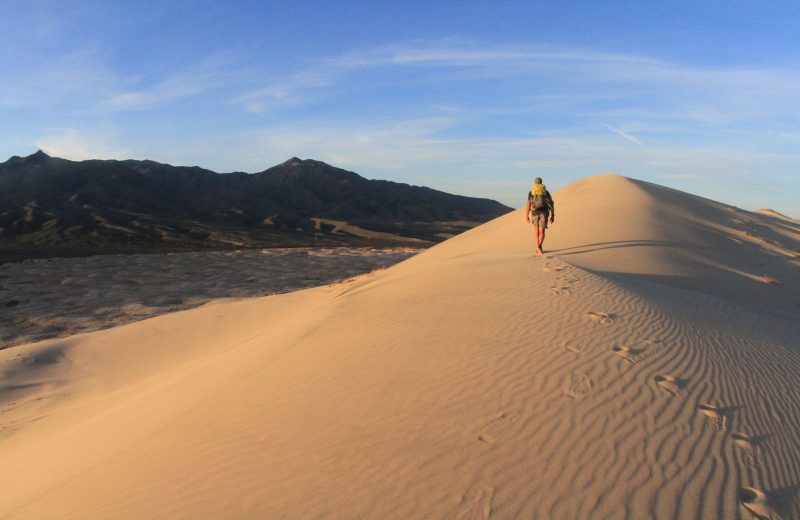
Take one of the many park ranger programs to learn more about the preserve and the flora and fauna that call it their home. Options include guided hikes, such as up to Teutonia Peak, dark sky astronomy programs, full moon hikes, a chance to see the desert tortoises, a talk by an archaeologist about the petroglyphs and many others.
Joshua Tree National Park
Joshua Tree National Park is located in southern California and has an almost stark beauty. If you want a unique landscape, then this is the place to be. The terrain is made up of boulders and buttresses, rugged mountains, desert plains, and of course, the weird little Joshua Trees.
When in the park, one of the best things to do is to take the Indian Cave Nature Trail, which is one of the best places to witness the park’s namesake flora. At just 0.6 miles, this is a short and sweet path surrounded by boulders and Joshua Trees.
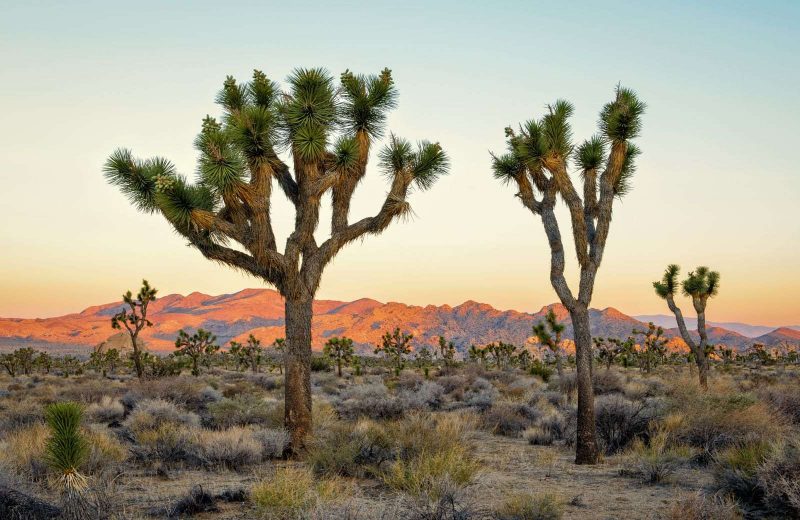
It is also worth taking the hike up to Keys View, the highest point in the park. You will be treated to a stunning view of the Coachella Valley, Palm Springs, and on a clear day, all the way to Mexico.
The park is a rock climbers paradise, with more 8000 known climbs and 400 unique formations. It has plenty of routes for both advanced climbers and beginners, and you don’t even have to bring your own gear, as you can rent it at the park.
Sequoia National Park
Located in the southern part of the Sierra Nevada Mountains, Sequoia National Park will take your breath away. The trees here are sure to be like nothing you have ever seen before. The whole park stretches across 40,000, but you’ll likely only need a day here to really see the highlights.
The Giant Forest is the most well-known part of the park and is the part that most people will visit on a road trip as this is where the really huge trees can be found. This area is home to some of the largest and oldest coastal redwoods in the world. The size of these trees really needs to be seen to be believed.
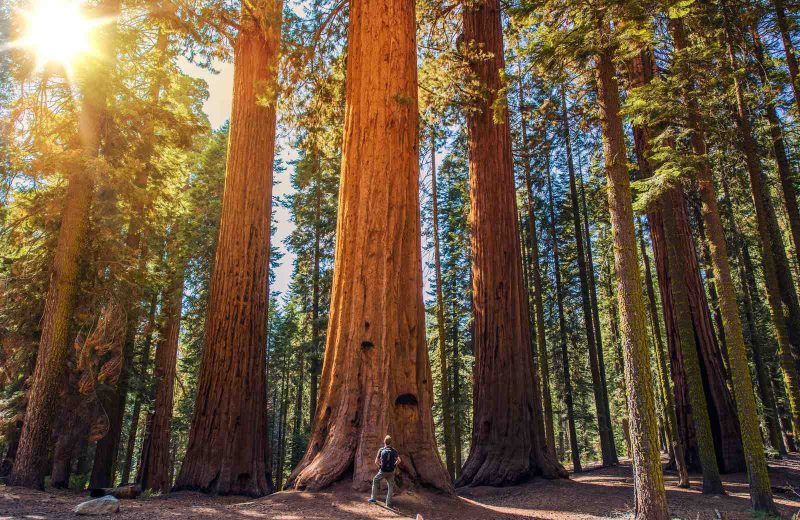
Of course, you can’t visit the park without visiting the biggest tree in the world, General Sherman. He stands at 275 feet tall and at the base is 36.5 feet wide.
To reach the tree, it is only a mile round trip, so it should definitely be on your to-do list. For a little longer hike, try the 3.4 miles round trip to Tokopah Falls, a 1200 foot waterfall that cascades down a rocky cliff.
If it is trees you want to see, then the Big Trees Loop is the hike to pick, taking you along the fringes of a beautiful meadow that is completely surrounded by giant sequoia trees. The interpretive panels will help you understand more about the area.
One of the very best things to do in the park is climbing the stairway to the clouds up to Moro Rock. The dramatic overlook offers an incredible view of the canyon below.
READ MORE: 15 Things To Do in Sequoia National Park
Death Valley
Crossing the borders of both California and Nevada is Death Valley, National Park. This park is extraordinary for so many reasons, with lots of different areas to explore; it deserves a spot on your southwest road trip. It is the largest national park in the contiguous United States and is made up of sand dunes, salt flats, badlands, canyons, valleys, and mountains.
Throughout the years, the lands have been shaped by the ever-changing weather, creating some truly spectacular landscapes. It is one of the hottest, driest and lowest parts of the country.
Mesquite Flat are the most popular dunes in Death Valley, rising to 328 feet, they make for the perfect place to go sandboarding. You must also visit the Badwater Basin, one of the largest salt flats in the world. It is also the lowest point in the US at 282 feet below sea level.
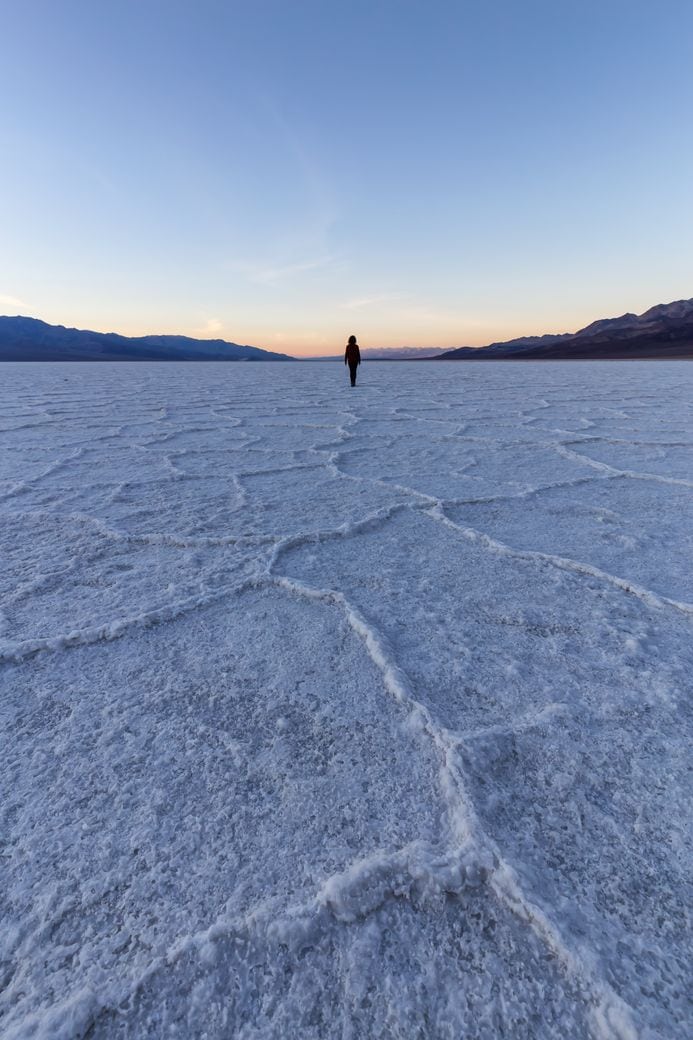
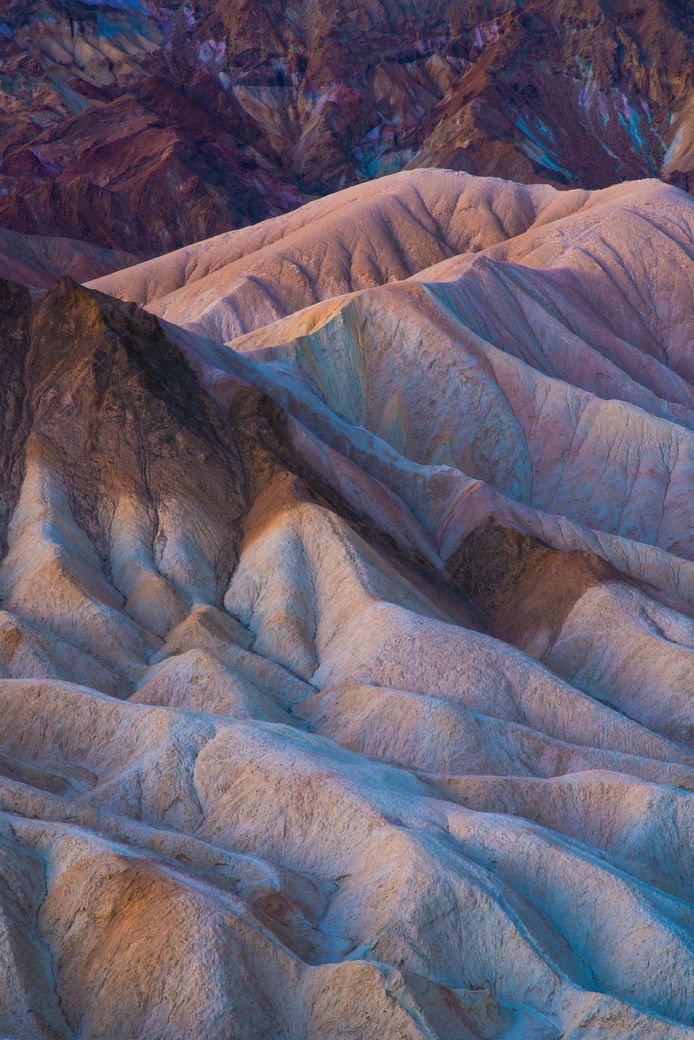
Pack your bike and explore the park’s extensive network of dirt roads. Just make sure you are equipped with maps and water. There are also plenty of operators that offer bike tours. For some incredible views, check out both Zabriskie Point and Dante’s View, you won’t be disappointed.
One of the most incredible things to do in the park is stargazing. You will never see the night sky quite like it, completely devoid of light pollution, o a clear night; the sight will take your breath away. So amazing are the skies here, it has been classified as a Dark Sky Park, and rangers lead frequent night sky programs.
Los Padres National Forest
Los Padres is a hiking lover’s dream, containing over 1,200 miles of trails, there is something for everyone. The area is huge, covering 1.7 million acres, from Monteray to northern Los Angeles. The ecosystems here range from the redwood forest to semi-desert, with elevations reaching up to almost 9000 feet.
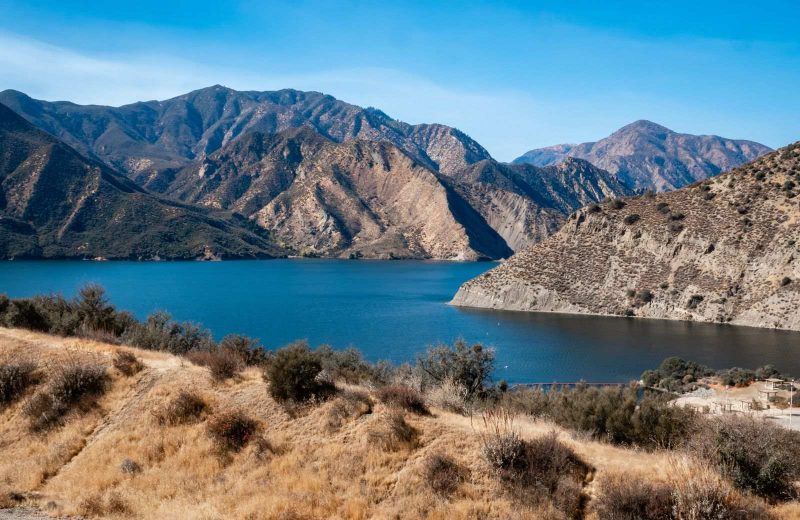
Hiking is undoubtedly the best way to experience the forest, with trails of varying lengths and elevations. Most also allow mountain biking, which will allow you to cover more ground quickly. One of the most popular trails is the Rattlesnake Trail through Rattlesnake Canyon.
Alternatively, the 1-mile hike to Montecito Peak will reward you with some incredible vistas. The Three Ponds Beyond Seven Falls Trail is a challenging mix of bouldering, hiking, and water fun, offering some great chances to cool off from the California heat.
RELATED: Seattle to San Francisco West Coast Road Trip! Adventures and Waterfalls
Pfeiffer Big Sur State Park
You don’t have to be from California to have heard of the Bug Sur area, a stunning bit of coastline with incredible views at every turn. On the central coast of California, this state park stretches for 1000 acres over the Big Sur River, sloping down the west side of the Santa Lucia Mountains.
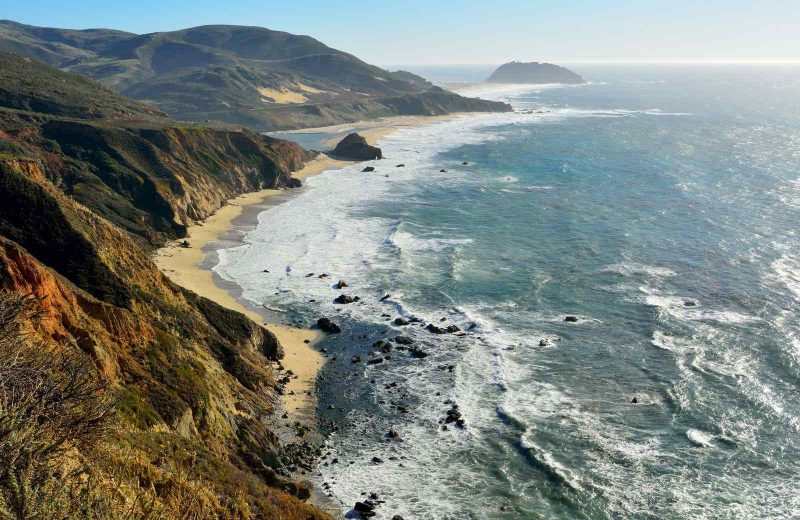
There is so much to do on this stretch of coast, from excavating jade at the Sand Dollar Beach to admiring the redwoods at Limekiln State Park. Be sure to pull over and watch McWay Falls cascade directly into the ocean.
Yosemite National Park
Yosemite is one of America’s most well known National Parks, and for good reason, and is also one of the best things to do in the southwest. With towering cliffs, incredible waterfalls, and deep valleys, it has a lot to offer. It is located in the Sierra Nevada Mountains in California, spanning nearly 1200 square miles.
Yet, despite its size, most people tend only to explore the 7-mile area of the valley, which is home to the most iconic viewpoints and landmarks.
One of the most iconic sites in the park is Tunnel View, and if you don’t do anything else when visiting, be sure to at least check out this incredible viewpoint. It is super accessible, right next to Wawona Tunnel, and can be accessed by simply using the pull-off from the road. Another must-see is Yosemite Falls.
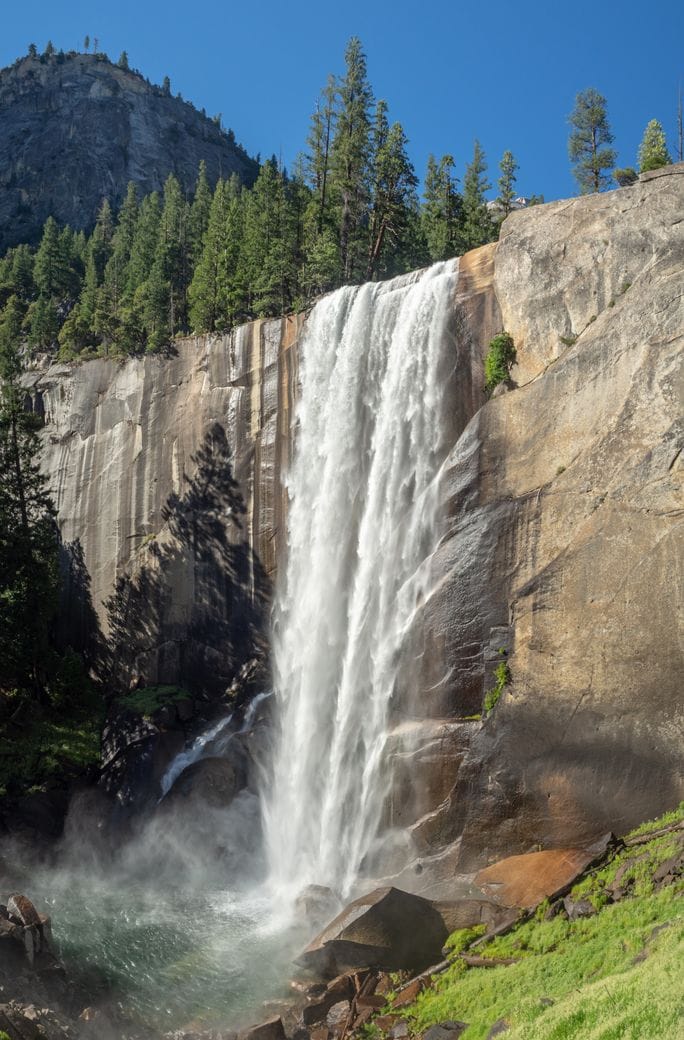
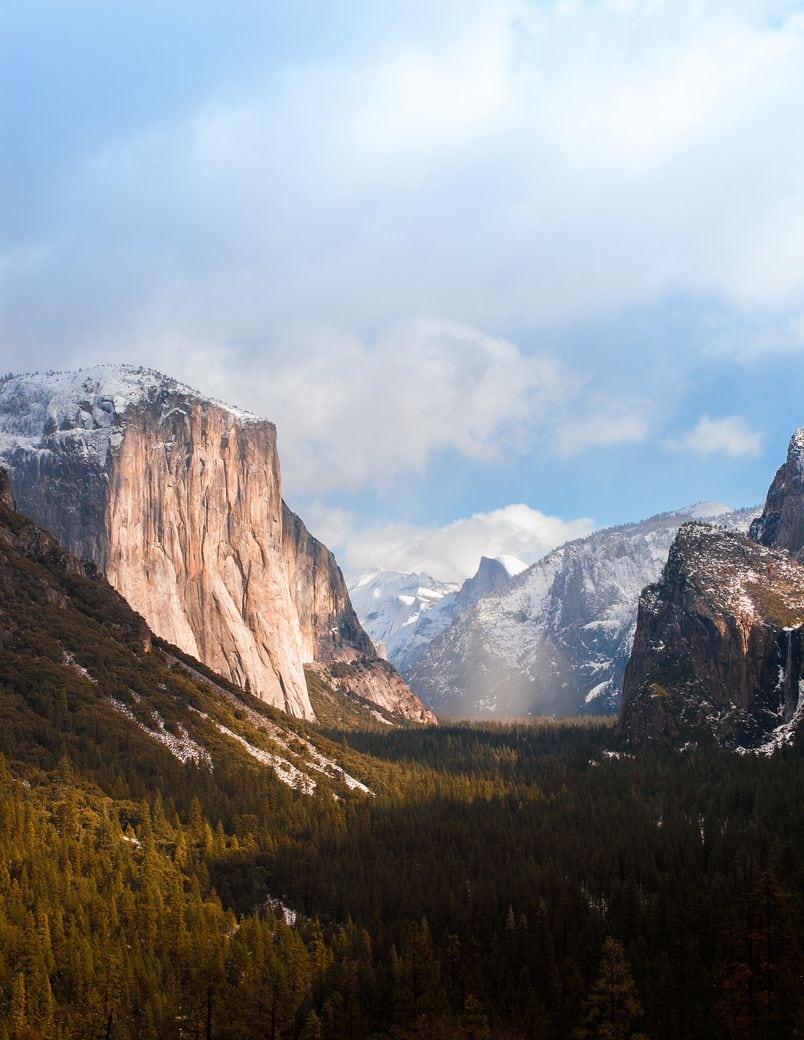
Although there are lots of waterfalls in the valley, this is one of the best and most iconic. You can get a close up look of the falls by following either the Lower or Upper Yosemite Falls Trail. At 2424 feet, it is the tallest waterfall in North America. The Upper Falls Trail is 7.2 miles long and is pretty tough, with many switchbacks and rocky stairs helping you with the climb. The Lower Falls Trail is much easier. A mile long, it will take you to a footbridge at the base of the waterfall.
If you just want to stretch your legs and see the sights, take the 1 mile Cook’s Meadow Loop Trail that offers great views of the falls and the iconic half Dome from the valley floor.
Southwest Road Trip Itinerary
“OK, Nina, this is great, and all but you just gave me so many choices how do I know what to actually do and what I can actually fit in?!”
This is NOT easy, guys! It’s SO hard to choose what to see, it’s hard to predict how many hours of driving in between and around areas will take (HINT: it’s always longer than Google maps says), and it’s difficult to organize yourself in new places. I get it. Hopefully, this next bit helps…
Southwest Itinerary #1 – 4-8 Weeks
There are over 30 amazing places/areas/parks on this list. If you were to only spend one day at each, you’d be looking at a one-month itinerary. And this doesn’t include driving in between, so you’d need to add on to that. Realistically, it could take you over six to eight weeks to complete this entire list, and it would still only be scraping the surface because one day at some of these spots is simply not enough.
Of course, if you were to take off some of the “stragglers” like Salt lake, Tahoe, perhaps New Mexico, then you’d have fewer detours, which would save some time.
Southwest Itinerary #2 – 1-3 Weeks
If you don’t have over a month to meander this gorgeous area (*insert sad face*), then we can tone it down a notch and refocus our travels to include less and therefore drive around less. My recommendation, if you were to have just a few weeks, would be to do the activities around southern Utah, northern Arizona, and maybe even the spots outside of Vegas.
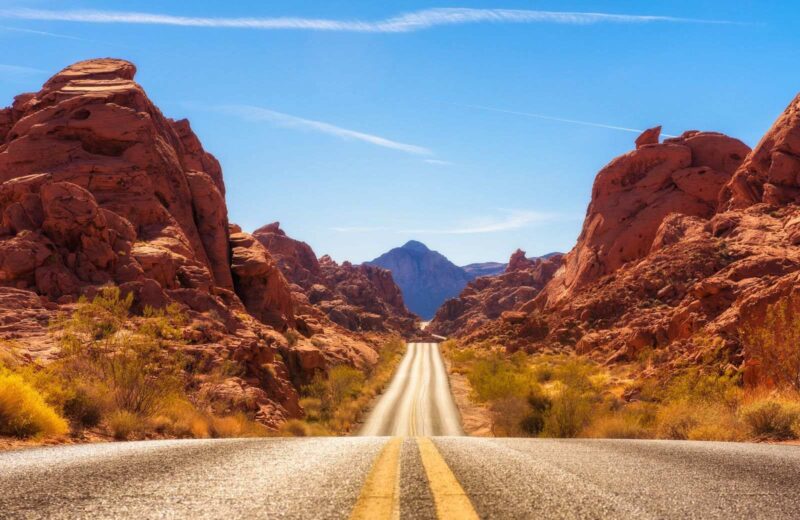
This area has the greatest concentration of cool things to do, and you won’t be driving across entire states to get places! Of course, with only a couple of weeks, you still might not be able to fit in every single thing, but you’ll get a good chunk done.
If you’re here for only around a week or so, you can probably get a few highlights in around southern Utah and northern Arizona OR spend your time just in southern California.
Southwest Itinerary #3 – 3-4 Weeks
If you have just a bit longer for your road trip, I’d say you can do southern Utah, northern Arizona, the spots outside of Vegas, and perhaps add on some of southern California’s amazing places to your itinerary.
RELATED: California Road Trip Itinerary: 19 Must-Visit Stops!
Some Things to Think About Before Your Southwest Road Trip
- Where are you starting your road trip from (and how long do you have)? Make sure to fly into a place that makes sense. Are you circling back or ending in a new place? Most car rentals will incur an extra charge to return a vehicle in another location so keep this in mind.
- Which season are you coming in? This area of the US DOES get snow! Roads close, winters can be brutal, and parks and places could be closed. If you don’t want to deal with too much snow, I’d say staying in AZ and south CA would be best.
- Which places are you MOST excited about? Mark those on the map and then add in the cool places around those places to keep your trip more concentrated instead of scattered. On the other hand, if you want to see a few musts but they are far apart, you have to accept that you’ll be skipping places in between and perhaps spending an entire day just driving.
- LESS IS MORE! Please, if you’re not from the USA, it might be hard to understand how gigantic our country is. Denver to LA is around 16 hours, no stops. This is rough to do in two days with minimal stops. If you’re trying to see things along the way and you only have a week or so, there’s only so much you can fit in. That’s maybe around four days to make stops along the way, which isn’t much. Add more days or consider not making such a long stretch. None of us want to go on an epic road trip and drive for more than 50% of the time, right?
I hope this post helped you plan some epic Southwest road trips around the States. Which one of these places are you most excited to visit? Let me know in the comments below!
Don’t lose this! Click to pin it now.
